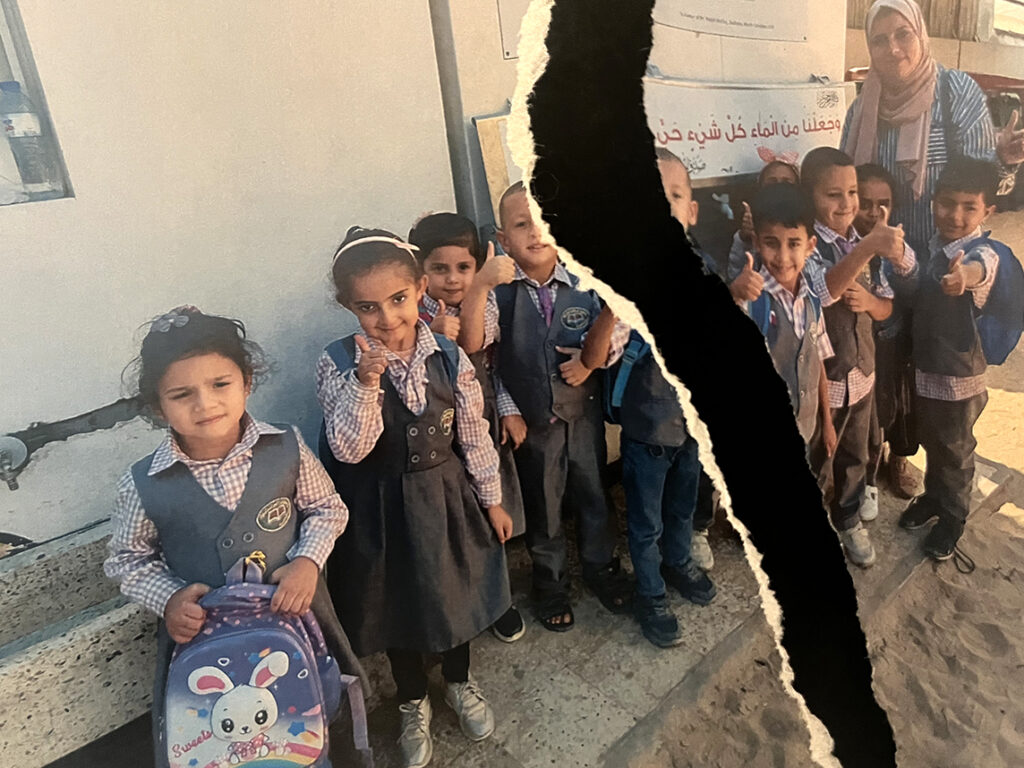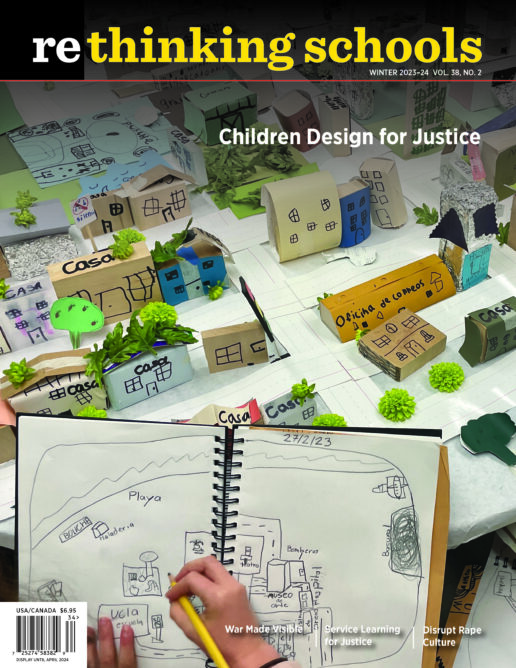War Made Visible

From language arts to math to science to social studies, the school curriculum teaches young people what to think about. But it also teaches young people what not to think about. What not to question. What not to care about. And crucially: who not to care about.
In an important new book, War Made Invisible: How America Hides the Human Toll of Its Military Machine, Norman Solomon reveals how we are taught to ignore U.S. war spending, war making, and those others our country wages war against. The “America” in the book’s subtitle focuses on mainstream media and U.S. government officials. Solomon dubs it the military-industrial-media complex. But it could more properly be described as the military-industrial-media-educational complex, as educators and education corporations are complicit in the processes the book reveals.
War Made Invisible opens with an epigraph from Aldous Huxley, written in 1936: “The propagandist’s purpose is to make one set of people forget that certain other sets of people are human.” In contrast, our job as educators is to equip students with the skills to recognize, critique, and actively oppose the propaganda of militarism, colonialism, and white supremacy. This kind of education will look different in kindergarten from how it does in middle school humanities or high school chemistry, but this work belongs to all of us.
As we pointed out more than 30 years ago in our book Rethinking Columbus, the moment young children learn about Columbus arriving in a “new” land, planting the flag, claiming territory in the name of an empire thousands of miles away, and naming it San Salvador, young people are led to celebrate an act of naked imperialism. The people Columbus “discovers” become los nadies, in the words of Eduardo Galeano — the nobodies, without history, language, or rights. This myth of discovery launches children on a curricular journey that too often teaches them to “forget that certain other sets of people are human.” U.S. history textbooks politely frame wars against Indigenous peoples as “Westward Expansion,” and label the outcome of the sadistic 1846–1848 war against Mexico with the genteel term “Mexican Cession.” Most often, the standardized K–12 curriculum teaches children to see the world through the eyes of invaders.
In his 1967 Riverside Church speech denouncing the U.S. war in Vietnam, Dr. Martin Luther King Jr. called the United States “the greatest purveyor of violence in the world today.” It still is. Solomon cites the Brown University Costs of War Project describing the effect of two decades of the U.S.-sponsored “war on terror”:
- At least 929,000 people have died due to direct war violence, including armed forces on all sides of the conflicts, contractors, civilians, journalists, and humanitarian workers.
- Many times more have died indirectly in these wars, due to ripple effects like malnutrition, damaged infrastructure, and environmental degradation.
- Over 387,000 civilians have been killed in direct violence by all parties to these conflicts.
- Over 7,050 U.S. soldiers have died in the wars.
- 38 million people have been displaced by the post-9/11 wars in Afghanistan, Pakistan, Iraq, Syria, Libya, Yemen, Somalia, and the Philippines.
- The U.S. government is conducting counterterror activities in 85 countries, vastly expanding this war across the globe.
The United States maintains 750 military bases outside its borders — by comparison, Russia has about three dozen, China five. The United States spends more on its military than the next 10 countries combined. The fiscal year 2022 budget for the Pentagon was a staggering $768 billion. But a few months after congressional authorization, President Biden requested a record $813 billion for 2023. As Solomon notes, at 51 percent of discretionary funding, the war budget “sops up funds that could be devoted to health care, education, housing, job creation, and much more.” As he notes sardonically, with a total revenue of $3.1 trillion over the last 20 years, “Outfits like Lockheed Martin, Raytheon, General Dynamics, Boeing, and Northrop Grumman have never lost a war.”
Teachers need to challenge the curricular “patterns of convenient silence,” and lift “the fog that obscures the actual dynamics of militarism far away and close to home.” For decades, the United States has waged war against people we never see, people whose names we don’t know, whose stories we can’t hear. Sometimes U.S. soldiers do the shooting, but more often, the United States wages war at a distance, with bombers, with drones, and with proxies — countries that use U.S. weapons to kill and oppress.
We write during the catastrophe unfolding in Gaza. Gaza has been a speck, hidden away in the mainstream curriculum. For example, the Glencoe/National Geographic textbook Exploring Our World on the Eastern Hemisphere offers three paragraphs on Gaza. The book quotes no Gazans. Nothing describes life there. A color map of the region indicates areas “Acquired by Israel in 1967” — like one might acquire a new wardrobe. Holt McDougal’s Modern World History, describes Palestinians as “one Arab group,” quotes one Palestinian, and says nothing about Gaza other than that a large number of Palestinians live there.
Neither textbook alerts students that the United States is not a disinterested peacemaker in the Israel/Palestine struggle, but a major funder of Israel’s occupation and war making on Gaza and the West Bank. For decades, the United States has given Israel more than $3 billion a year — more aid since World War II than to any single country in the world. Last year, 99.7 percent of U.S. aid to Israel was military aid.
Gaza may be barely visible in U.S. schools, but every adult, every teenager living in Gaza knows that the United States of America supplies Israel with weapons that destroy its schools.
Israel has occupied or held Gaza under siege since 1967. Every Gazan has grown up in a land Israel has dominated militarily — and brutally — in one form or another. Thirty-four years ago, in the fall of 1989, a delegation of U.S. educators, including three Rethinking Schools editors, traveled to the West Bank and Gaza. At the time, Gaza was occupied by the Israeli military. In a report at the time, we wrote:
[A]fter our first night in Gaza our delegation awoke in the morning to what sounded like gunfire. “They are firing tear gas into the school,” our host calmly told us. “This is very common.” When we returned to the school that afternoon, children greeted us at the gate with “rubber” bullets and tear gas canisters they’d collected that morning. When we entered the house, our host told us that, an hour before, a child had been shot in the chest at the school as classes ended for the day.
Hospital officials we interviewed in Gaza, Jerusalem, Nablus, and Jenin, as well as human rights investigators in Jerusalem and Ramallah all confirmed that soldiers regularly surround schools and fire at students as they arrive or leave. One 13-year-old we spoke with in a Gaza hospital told us that he was shot during a 20-minute break as he mingled with friends in the school garden.
We still have one of these silver, metallic CS gas canisters — Made in the USA — that we brought back to show students here. Gaza may be barely visible in U.S. schools, but every adult, every teenager living in Gaza knows that the United States of America supplies Israel with weapons that destroy its schools, clinics, markets, and apartment buildings, and that kill its people. For decades, U.S. taxpayers have funded weapons used to terrorize Palestinian children.
Of course, it is not just Gaza and the Occupied Territories: Iraq. Vietnam. Guatemala. Haiti. The Marshall Islands. Chile. Syria. . . .
Through various means, the United States has waged war on countless peoples — and U.S. weapons continue to be used. Of course, in some of these places — e.g., Vietnam, with lingering effects of Agent Orange, and unexploded ordnance; the Marshall Islands, target of some 60 nuclear blasts, leaving a toxic radioactive legacy — hostilities may have ended, but warfare is ongoing. Yet the corporate media and curricular silences, abstractions, euphemisms, and sometimes lies prevent students from being able to touch the lives of the victims of our wars. As Solomon writes, “Without a single standard of human rights and empathy for the victims of war, we lose human connection with them. And with ourselves.”
What are the implications for social justice educators?
First, from the earliest grades, we need a curriculum of empathy and connection, one that alerts children to the voices of people too often silenced. We need to invite children to listen for those silences, to help them try to put themselves in the shoes of others, however imperfectly they may be able to do that — through picture books, stories, interior monologues, math and science investigations, “write that I” poems, dialogue poems, role plays. We need a curriculum of multiple perspectives, always asking, “Whose voices are missing?”
And as uncomfortable as it may be, we have a moral responsibility to remember those our country has waged war against. It is not OK for us to curricularly disappear people whose lives the United States has devastated. This is not to say that we reduce people from Vietnam or Afghanistan or Gaza to mere victim units. We can story their resistance and resilience. We can help students recognize their humanity and dignity.
U.S. history is filled with courageous, imaginative antiwar and solidarity activists and movements, although you wouldn’t know that from looking at corporate textbooks. We should populate our curricula with war resisters: Frederick Douglass and Henry David Thoreau (against the Mexican war), Medea Benjamin, Eartha Kitt, Muhammad Ali, Jeannette Rankin, Chelsea Manning, Norman Morrison, Rachel Corrie. Our students need models of people who, in countless ways, said NO to war. Antiwar inspiration should course through our curricula.
In her review/essay in the winter issue of Rethinking Schools [“‘Yes, Sir’ — Turning Students into Soldiers”] Sylvia McGauley describes the long and important struggle against school militarism. McGauley quotes the socialist leader Eugene V. Debs who went to prison for opposing World War I: “I would no more teach school children military training than teach them arson, robbery, or assassination.” And yet, JROTC programs in high schools across the country lure even middle schoolers into military training. And as anyone who has spent time in a high school with large numbers of students of color or white working-class kids knows, even without an active JROTC program, recruiters prowl hallways, promising the world to students who they hope will mortgage their futures to the military. We should revive and support counter-recruitment efforts — and support our students when they act against war and militarism.
As Norman Solomon argues convincingly in War Made Invisible, the United States is engaged in a perpetual state of war — often hidden or lied about in the corporate media. Schools have been partners in that deception. Instead, we need schools to nurture a disgust for war and to expose students to the human consequences of the U.S. war machine. We need young people to come to see themselves as activists for peace and justice — to recognize our common humanity and do something about it.

